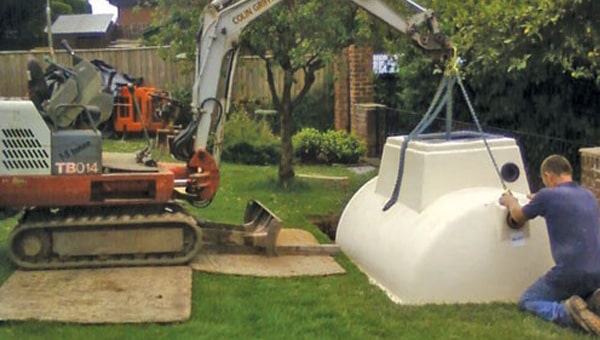Sewage treatment plants are ideal for properties that require an off-mains drainage system, usually because they’re too far from a mains connection or the system in the area has reached maximum capacity.
Whilst you can install sewage treatment yourself, we always recommend seeking advice and guidance from a professional – especially if you don’t have the tools and skills required.
The team at Cotterill Civils have been installing sewage treatment solutions for commercial, industrial and agricultural clients for more than 30 years and can assist you in choosing (and installing) the best wastewater solution for your needs.
Let’s take a closer look at what the process of sewage treatment installation involves.
Table of Contents
Step 1 – check legislation
Installing an off-mains drainage system can be a daunting concept – and that’s without looking into the legalities.
There are rules and regulations for everything – from the type of tank that is suitable for a property to where it can be installed, discharged and what ground conditions are acceptable.
It’s crucial that you comply with all of these regulations, as failure to do so could have serious consequences for the environment, and you (the property owner) could face prosecution.
As a general rule of thumb, your sewage treatment plant must be EN12566-3 tested to ensure it’s safe and legal in the UK. And the outlet from the tank needs to be at least 10 metres from the nearest building and 50 metres from a water supply.
Step 2 – conduct a site survey
Before you start thinking about buying and installing a sewage treatment solution, you need to evaluate the area it will be installed. This will help you to identify the most suitable system.
It’s also worth noting that, if any part of the building your sewage treatment plant will serve is within 30 metres of a public sewer, you’ll need permission from the national environmental agency, so you can discharge sewage to a different system.
You’ll also require consent if the outlet will be within 500 metres of special areas of conservation, biological sites, protected shellfish water or designated bathing water, 200 metres of a local nature reserve and 50 metres of a local wildlife site.
The findings from the site survey will impact the design of your sewage treatment plant.
Step 3 – contact a professional to install it
After taking time to understand the legalities included with off-mains drainage and designing the system to fit your criteria, the next step is to install it.
The installation of such systems should always be carried out by a fully qualified professional with the appropriate tools and knowledge, like the Cotterill Civils team. Though you’ll pay a little extra to have your sewage treatment solution installed professionally, the cost of repairs and fines often work out more expensive in the long run.
An expert will:
- inspect the tank for damage before installing it
- check the depth of incoming pipework to ensure the tank will connect to the existing pipework
- assess the planned location against the guidelines in the manual
- make sure the hole is large enough for the tank and backfill
- carefully lower the tank into the hole and check that it is level
Step 4 – understand how the system operates
Although sewage treatment plants are usually self-regulated, it still pays to know how they work.
Unlike normal mains sewers, sewage treatment plants use colonies of natural micro-organisms (biomass) to break down the pollutants in sewage that you flush, wash and drain away. Certain chemicals in household cleaning products can harm this biomass, especially if they are used excessively, resulting in foul smells and system failure.
Therefore, you need to be mindful of what wash powders you use in your washing machine and dishwasher, not to mention washing up liquids in the sink. Though they’re generally safe to use, some floor cleaners and bleaches can damage the biomass – so avoid pouring them down your drains without diluting them first.
Step 5 – maintain it
Thinks like desludging and keeping covers free from obstruction are key once your sewage treatment plant is in place, allowing you to keep it in working order for as long as possible.
Whilst some manufacturers offer some sort of maintenance agreement and service plan, not all of them do – so it’s well worth finding out before you install your system.
If your sewage treatment plant doesn’t come with maintenance, you should arrange to have your system looked at annually – particularly the sludge return, blower or pump, filters, alarm, ventilation, covers and locks.
In between services, it’s a sensible idea to check the vents to ensure they aren’t blocked and make sure the blower is functioning effectively by listening out for a gentle hum. This way, if you spot any problems with your system, you can have them looked at and repaired before the issue escalates into something far worse.

